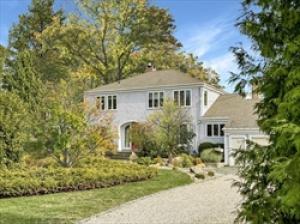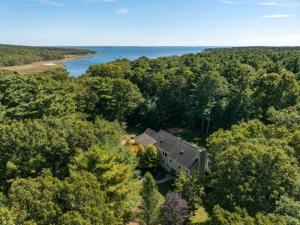The storied history of the Old Southworth Library
Story Location
United States
Old Southworth Library, a beloved fieldstone building on Elm St. in Padanaram, is an iconic building in town, but its history is less widely known.
With the building now set to become a nonprofit arts center, Dartmouth Week sifted through historical documents and books to uncover the building’s well-documented past.
In 1878, the pastor of the Congregational Church of South Dartmouth founded a literary and social group for the purpose of opening a library — initially only for residents of Padanaram Village. Young people put on theatrical and musical performances, and after a year had raised enough money for the pastor, Rev. Salter F. Calhoun, to go to Boston and buy books.
The initial collection was composed of eight books: biography, travel, history, and one novel: Romola, by George Eliot.
The collection grew and was moved to the upstairs room of Potter’s Store, which was located near the intersection of Elm and Bridge Streets. After a fire, it was transferred to a small building across the street that also housed a boy’s club.
The village doctor, Andrew B. Cushman, was looking for a location to practice medicine from, and offered to pay the rent, $24 a year, and fuel costs for a library location in exchange for using it as his office.
The land for what would become the Old Southworth Library was sold to the Library Association for $200 by Captain George O. Baker on March 3, 1888. Baker was a member of the family for whom Bakerville is named, and was a fairly eccentric character.
He was interviewed by the New Bedford Evening Standard in 1912 around his 77th birthday, and told a reporter that on an 1869 South American cruise, “I went to a banquet with a governor in Ecuador, and we feasted off fricasseed parrots and roasted monkeys.”
With land secured, all that was needed was funds. On Christmas Eve in 1888, John Haywood Southworth donated the funds to establish a permanent library and 2,500 books in memory of his father, Deacon John Southworth. The architect R. H. Slack and Samuel Davis agreed to furnish a design and materials. The two-story, 1,999 square foot building was constructed for a cost of $4,785.
The building featured a semi-circular reference room with a fireplace and another room with a charging desk and the fiction collection. The children’s collection was housed in the basement.
The library was dedicated on Saturday, February 1, 1890. At the ceremony, Reverend Martin S. Howard read a poem he had composed for the occasion:
The noble thoughts of bygone days;
The legends of old; the poet’s song;
The wisdom of philosophy;
The thrilling tale where right and wrong
In conflict met in deadly clasp;
The stirring deeds of history;
The strifes and toils of human souls;
The world’s great efforts to be free,
Shall here be told in prose and rhyme;
The peerless names of earth shall come
With all their stores and priceless wealth,
Thanks to the foresight that conceived
So wise and rich and rare a gift;
That sought the nobler part of man
To bless, refine, reclaim, uplift.
The library’s catalogue had 2,500 books. A library card cost 50 cents, and late fees were 1 cent per day.
In 1921, the Padanaram Association donated $475 to provide the library with modern plumbing and running water. That same year, $100 was used to establish a branch library at Town Hall, which included many books in Portuguese.
In 1927, Town Meeting members voted to acquire the library as a town. By that point, the library’s collection had grown to 17,921 books.
The library served as a gathering place for unemployed boys during the Great Depression. In 1942, the library ran a Victory Book Drive and collected 1,200 books which were sent to the Army encampment on Mishaum Point.
By 1958, the library had outgrown the Old Southworth building, but it wasn’t until the April Town Meeting in 1967 when the town agreed to spend $515,000 on building a new library. The town had been reluctant because of the difficulty of finding a location convenient to the whole town, the cost of the project, and a strong sentimental attachment to the Old Southworth building.
After the current Southworth Library was built on Dartmouth Street, the Old Southworth Library building housed a senior center and the Dartmouth Natural Resources Trust, but has been empty since summer 2016.
Town Meeting rejected a proposal to sell the building, which led to town officials to issue several rounds of requests for proposals seeking a tenant. In the aftermath of the failed Town Meeting vote, a group of residents formed “Save Old Southworth,” now known as the Dartmouth Cultural Center, to pitch a proposal to transform the building into a nonprofit arts center. The group’s lease was approved in late August and began September 1, ushering in another unique use in the Old Southworth Library’s long history.
This article is based on the in-depth and well-written research of Elsie Haskell, compiled in her manuscript “History of the Dartmouth Libraries,” available to read at the Southworth Library, and Peggi Medeiros’ 1987 recommendation to the Massachusetts Historical Commission that the Old Southworth Library be added to the State and National Registers of Historic Buildings.












































